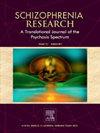Stage-specific computational mechanisms of working memory deficits in first-episode and chronic schizophrenia
IF 3.5
2区 医学
Q1 PSYCHIATRY
引用次数: 0
Abstract
Background
Cognitive dysfunction, particularly working memory (WM) impairment, constitutes a core feature of schizophrenia and is largely unresponsive to available antipsychotic treatments. The computational mechanisms underlying WM deficits at different illness stages and their associations with clinical symptom dimensions remain poorly understood.
Methods
We applied hierarchical drift diffusion modeling (HDDM) to dissect latent cognitive processes underlying WM performance in a two-back task among patients with first-episode schizophrenia (FES, N = 103, illness duration ≤2 years), chronic schizophrenia (ChSz, N = 108, illness duration ≥5 years), and healthy controls (HCs, N = 85). Multiple regression and mediation analyses were conducted to examine associations between HDDM parameters, clinical symptoms, and conventional metrics.
Results
Both patient groups exhibited significant WM deficits compared to HCs, with ChSz patients demonstrating more pronounced impairments than FES patients. HDDM analysis revealed that patients showed significantly reduced drift rate and prolonged non-decision time compared to HCs. Notably, while non-decision time remained comparable between FES and ChSz groups, drift rate was significantly lower in ChSz patients, mediated the relationship between illness stage and WM performance, and negatively correlated with negative symptoms and general psychopathology.
Conclusions
This study reveals distinct computational profiles of WM deficits across different stages of schizophrenia. While non-decision time impairments emerge early and persist, reduced drift rate progressively deteriorates with illness duration and is closely linked to specific clinical symptoms. These findings enhance our understanding of WM dysfunction across illness stages and support the development of targeted cognitive interventions tailored to illness stage and symptom severity.
首发和慢性精神分裂症患者工作记忆缺陷的阶段特异性计算机制
认知功能障碍,特别是工作记忆(WM)损伤,是精神分裂症的一个核心特征,并且对现有的抗精神病药物在很大程度上没有反应。不同疾病阶段WM缺陷的计算机制及其与临床症状维度的关联仍然知之甚少。方法采用分层漂移扩散模型(HDDM)对首发精神分裂症(FES, N = 103,病程≤2年)、慢性精神分裂症(ChSz, N = 108,病程≥5年)和健康对照(hc, N = 85)患者在双背任务中WM表现的潜在认知过程进行分析。采用多元回归和中介分析来检验HDDM参数、临床症状和常规指标之间的关联。结果与hc患者相比,两组患者均表现出明显的WM缺陷,ChSz患者比FES患者表现出更明显的损伤。HDDM分析显示,与hc相比,患者的漂移率显著降低,非决策时间延长。值得注意的是,虽然非决策时间在FES组和ChSz组之间保持可比性,但ChSz患者的漂移率显著降低,介导了疾病分期和WM表现之间的关系,并与阴性症状和一般精神病理负相关。本研究揭示了精神分裂症不同阶段WM缺陷的不同计算谱。虽然非决策时间障碍出现较早并持续存在,但随着病程的延长,漂移率降低会逐渐恶化,并与特定的临床症状密切相关。这些发现增强了我们对不同疾病阶段WM功能障碍的理解,并支持针对疾病阶段和症状严重程度制定有针对性的认知干预措施。
本文章由计算机程序翻译,如有差异,请以英文原文为准。
求助全文
约1分钟内获得全文
求助全文
来源期刊

Schizophrenia Research
医学-精神病学
CiteScore
7.50
自引率
8.90%
发文量
429
审稿时长
10.2 weeks
期刊介绍:
As official journal of the Schizophrenia International Research Society (SIRS) Schizophrenia Research is THE journal of choice for international researchers and clinicians to share their work with the global schizophrenia research community. More than 6000 institutes have online or print (or both) access to this journal - the largest specialist journal in the field, with the largest readership!
Schizophrenia Research''s time to first decision is as fast as 6 weeks and its publishing speed is as fast as 4 weeks until online publication (corrected proof/Article in Press) after acceptance and 14 weeks from acceptance until publication in a printed issue.
The journal publishes novel papers that really contribute to understanding the biology and treatment of schizophrenic disorders; Schizophrenia Research brings together biological, clinical and psychological research in order to stimulate the synthesis of findings from all disciplines involved in improving patient outcomes in schizophrenia.
 求助内容:
求助内容: 应助结果提醒方式:
应助结果提醒方式:


